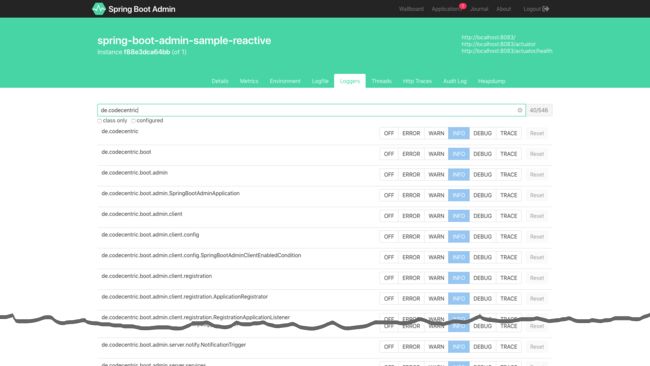本文基于:Spring Boot 2.1.3,理论支持Spring Boot 2.x所有版本。
作为程序猿,定位问题是我们的日常工作,而日志是我们定位问题非常重要的依据。传统方式定位问题时,往往是如下步骤:
- 将日志级别设低,例如
DEBUG; - 重启应用;
- 复现问题,观察日志;
如果能动态修改日志级别(无需重启应用,就能立刻刷新),那绝对 如猫添翼 。事实上,从 Spring Boot 1.5 开始,Spring Boot Actuator 组件就已提供动态修改日志级别的能力。
TIPS
- 其实更低版本也只需简单扩展,即可实现动态修改日志级别。
- 对Spring Boot Actuator感到陌生的童鞋,可先前往 Spring Boot Actuator 了解基础用法。
废话不多说了,亮代码吧。
编码
-
加依赖
org.springframework.boot spring-boot-starter-web org.springframework.boot spring-boot-starter-actuator 这里的
spring-boot-starter-web不是必须的,只是下面测试代码要用到。 -
写代码
package com.itmuch.logging; import org.slf4j.Logger; import org.slf4j.LoggerFactory; import org.springframework.web.bind.annotation.GetMapping; import org.springframework.web.bind.annotation.RestController; /** * @author itmuch.com */ @RestController public class TestController { private static final Logger LOGGER = LoggerFactory.getLogger(TestController.class); @GetMapping("/test") public String simple() { LOGGER.debug("这是一个debug日志..."); return "test"; } } -
写配置:
management: endpoints: web: exposure: include: 'loggers'由于Spring Boot 2.x默认只暴露
/health以及/info端点,而日志控制需要用到/loggers端点,故而需要设置将其暴露。
代码编写完成啦。
测试
/loggers 端点提供了 查看 以及 修改 日志级别的能力。
测试1:查看当前应用各包/类的日志级别
访问 http://localhost:8080/actuator/loggers ,可看到类似如下的结果:
{
"levels": ["OFF", "ERROR", "WARN", "INFO", "DEBUG", "TRACE"],
"loggers": {
"ROOT": {
"configuredLevel": "INFO",
"effectiveLevel": "INFO"
},
"com.itmuch.logging.TestController": {
"configuredLevel": null,
"effectiveLevel": "INFO"
}
}
// ...省略
}
测试2:查看指定包/类日志详情
访问 http://localhost:8080/actuator/loggers/com.itmuch.logging.TestController,可看到类似如下的结果:
{"configuredLevel":null,"effectiveLevel":"INFO"}
由测试不难发现,想看哪个包/类的日志,只需构造 /actuator/loggers/包名类名全路径 去访问即可。
测试3:修改日志级别
在 TestController 类中,笔者编写设置了一条日志 LOGGER.debug("这是一个debug日志..."); ,而由测试1,默认的日志级别是INFO,所以不会打印。下面来尝试将该类的日志级别设为DEBUG。
curl -X POST http://localhost:8080/actuator/loggers/com.itmuch.logging.TestController \
-H "Content-Type: application/vnd.spring-boot.actuator.v2+json;charset=UTF-8" \
--data '{"configuredLevel":"debug"}'
如上,只需发送一个POST请求,并将请求body设为:{"configuredLevel":"debug"} 即可。
此时,访问 localhost:8080/test 会看到类似如下的日志:
2019-03-28 16:24:04.513 DEBUG 19635 --- [nio-8080-exec-7] com.itmuch.logging.TestController : 这是一个debug日志...
并且,此时再访问 http://localhost:8080/actuator/loggers/com.itmuch.logging.TestController ,可看到类似如下的结果:
{"configuredLevel":"DEBUG","effectiveLevel":"DEBUG"}
说明已成功动态修改日志级别。
原理分析
TIPS
本节着重分析如何实现动态修改。
Actuator有约定, /actuator/xxx 端点的定义代码在 xxxEndpoint 中。故而,找到类 org.springframework.boot.actuate.logging.LoggersEndpoint ,可看到类似如下的代码:
@Endpoint(id = "loggers")
public class LoggersEndpoint {
private final LoggingSystem loggingSystem;
@WriteOperation
public void configureLogLevel(@Selector String name,
@Nullable LogLevel configuredLevel) {
Assert.notNull(name, "Name must not be empty");
this.loggingSystem.setLogLevel(name, configuredLevel);
}
// ...其他省略
}
其中, Endpoint 、WriteOperation 、@Selector 都是Spring Boot 2.0开始提供的新注解。
@Endpoint(id = "loggers") 用来描述Spring Boot Actuator 的端点,这样就会产生一个/actuator/loggers 的路径,它类似于Spring MVC的 @RequestMapping("loggers") 。
@WriteOperation 表示这是一个写操作,它类似于Spring MVC的 @PostMapping 。Spring Boot Actuator还提供了其他操作,如下表:
| Operation | HTTP method |
|---|---|
@ReadOperation |
GET |
@WriteOperation |
POST |
@DeleteOperation |
DELETE |
@Selector 用于筛选 @Endpoint 注解返回值的子集,它类似于Spring MVC的 @PathVariable。
这样,上面的代码就很好理解了—— configureLogLevel 方法里面就一行代码 :this.loggingSystem.setLogLevel(name, configuredLevel); ,发送POST请求后,name就是我们传的包名或者类名,configuredLevel就是我们传的消息体。
怎么实现动态修改的呢?不妨点进去看看,然后发现代码如下:
// org.springframework.boot.logging.LoggingSystem#setLogLevel
public void setLogLevel(String loggerName, LogLevel level) {
throw new UnsupportedOperationException("Unable to set log level");
}
嘿嘿,没事,肯定有实现类, 该方法在如下实现类被实现:
# 适用于java.util.logging的LoggingSystem
org.springframework.boot.logging.java.JavaLoggingSystem
# 适用于Log4j 2的LoggingSystem
org.springframework.boot.logging.log4j2.Log4J2LoggingSystem
# 适用于logback的LoggingSystem
org.springframework.boot.logging.logback.LogbackLoggingSystem
# 啥都不干的LoggingSystem
org.springframework.boot.logging.LoggingSystem.NoOpLoggingSystem
Spring Boot 2.x中,默认使用Logback,因此进入到 LogbackLoggingSystem 中,代码如下:
@Override
public void setLogLevel(String loggerName, LogLevel level) {
ch.qos.logback.classic.Logger logger = getLogger(loggerName);
if (logger != null) {
logger.setLevel(LEVELS.convertSystemToNative(level));
}
}
至此,就真相大白了。其实根本没有黑科技,Spring Boot本质上还是使用了Logback的API,ch.qos.logback.classic.Logger.setLevel 实现日志级别的修改。
你可能会好奇
你可能会好奇,LoggingSystem有这么多实现类,Spring Boot怎么知道什么情况下用什么LoggingSystem呢?可在 org.springframework.boot.logging.LoggingSystem 找到类似如下代码:
public abstract class LoggingSystem {
private static final Map SYSTEMS;
static {
Map systems = new LinkedHashMap<>();
systems.put("ch.qos.logback.core.Appender",
"org.springframework.boot.logging.logback.LogbackLoggingSystem");
systems.put("org.apache.logging.log4j.core.impl.Log4jContextFactory",
"org.springframework.boot.logging.log4j2.Log4J2LoggingSystem");
systems.put("java.util.logging.LogManager",
"org.springframework.boot.logging.java.JavaLoggingSystem");
SYSTEMS = Collections.unmodifiableMap(systems);
}
/**
* Detect and return the logging system in use. Supports Logback and Java Logging.
* @param classLoader the classloader
* @return the logging system
*/
public static LoggingSystem get(ClassLoader classLoader) {
String loggingSystem = System.getProperty(SYSTEM_PROPERTY);
if (StringUtils.hasLength(loggingSystem)) {
if (NONE.equals(loggingSystem)) {
return new NoOpLoggingSystem();
}
return get(classLoader, loggingSystem);
}
return SYSTEMS.entrySet().stream()
.filter((entry) -> ClassUtils.isPresent(entry.getKey(), classLoader))
.map((entry) -> get(classLoader, entry.getValue())).findFirst()
.orElseThrow(() -> new IllegalStateException(
"No suitable logging system located"));
}
// 省略不相关内容...
}
由代码不难发现,其实就是构建了一个名为 SYSTEMS 的map,作为各种日志系统的字典;然后在 get 方法中,看应用是否加载了map中的类;如果加载了,就通过反射,初始化响应 LoggingSystem 。例如:Spring Boot发现当前应用加载了 ch.qos.logback.core.Appender,就去实例化 org.springframework.boot.logging.logback.LogbackLoggingSystem 。
界面
本文是使用 curl 手动发送 POST 请求手动修改日志级别的,该方式不适用生产,因为很麻烦,容易出错。生产环境,建议根据Actuator提供的RESTful API定制界面,或使用 Spring Boot Admin ,可视化修改日志级别,如下图所示:
想修改哪个包/类的日志级别,直接点击即可。
配套代码
GitHub:https://github.com/eacdy/spring-boot-study/tree/master/spring-boot-logging-change-logging-level
Gitee:https://gitee.com/itmuch/spring-boot-study/tree/master/spring-boot-logging-change-logging-level
原文首发
http://www.itmuch.com/spring-boot/change-logger-level/

